Honda HRX217VKA Owner's Manual
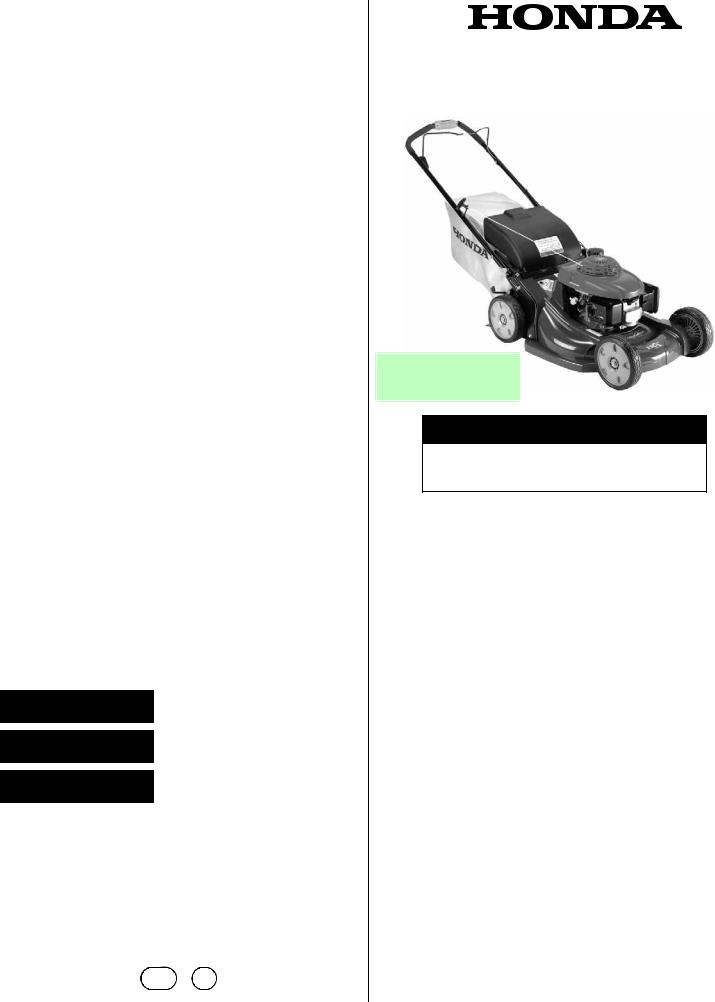
INTRODUCTION
Congratulations on your selection of a Honda lawn mower! We are certain you will be pleased with your purchase of one of the finest lawn mowers on the market.
We want to help you get the best results from your new mower and to operate it safely. This manual contains the information on how to do that; please read it carefully.
We suggest you read the DISTRIBUTOR’S LIMITED WARRANTY (page 19) and EMISSION CONTROL SYSTEM WARRANTY
(page 20) to fully understand coverage and your responsibilities of ownership.
When your mower needs scheduled maintenance, keep in mind that an authorized Honda servicing dealer is specially trained in servicing Honda mowers and is supported by the parts and service divisions of American Honda. Your Honda dealer is dedicated to your satisfaction and will be pleased to answer your questions and concerns.
Keep this owner’s manual handy so you can refer to it at any time. This owner’s manual is considered a permanent part of the lawn mower and should remain with the lawn mower if resold.
The information and specifications included in this publication were in effect at the time of approval for printing. American Honda Motor Co., Inc. reserves the right, however, to discontinue or change specifications or design at any time without notice and without incurring any obligation whatever. No part of this publication may be reproduced without written permission.
SAFETY MESSAGES
Your safety and the safety of others are very important. We have provided important safety messages in this manual and on the mower. This information alerts you to potential hazards that could hurt you or others. Please read these messages carefully.
Of course, it is not practical or possible to warn you about all the hazards associated with operating or maintaining a lawn mower. You must use your own good judgment.
You will find important safety information in a variety of forms:
•Safety Labels – on the lawn mower.
•Instructions – how to use this mower correctly and safely.
•Safety Messages – preceded by a safety alert symbol and one of three signal words: DANGER, WARNING, or CAUTION. These signal words mean:
DANGER
WARNING
CAUTION
You WILL be KILLED or SERIOUSLY HURT if you don't follow instructions.
You CAN be KILLED or SERIOUSLY HURT if you don't follow instructions.
You CAN be HURT if you don't follow instructions.
Each message tells you what the hazard is, what can happen, and what you can do to avoid or reduce injury.
•Damage Prevention Messages – You will also see other important messages that are preceded by the word NOTICE. This word means:
|
|
Your lawn mower or other property can be |
|
NOTICE |
|
|
damaged if you don’t follow instructions. |
|
|
|
|
|
||
© 2003-2012 American Honda Motor Co., Inc.—All Rights Reserved |
||
31VH7V310 |
EM5 |
K3 |
POM31VH7V310 |
00X31-VH7-V310 |
HPE.2012.04 |
||
|
|
|
PRINTED IN U.S.A. |
OWNER’S MANUAL
HRX217VKA
Click here to save this manual to your
WARNING:
The engine exhaust from this product contains chemicals known to the State of California to cause cancer, birth defects, or other reproductive harm.
CONTENTS |
|
INTRODUCTION...................................... |
1 |
SAFETY MESSAGES .............................. |
1 |
LAWN MOWER SAFETY......................... |
2 |
IMPORTANT MESSAGE TO |
|
PARENTS......................................... |
2 |
SAFETY LABEL LOCATIONS.......... |
2 |
SETTING UP YOUR MOWER ................. |
3 |
CONTROL LOCATIONS.......................... |
4 |
BEFORE OPERATION ............................ |
4 |
IS YOUR LAWN MOWER READY |
|
TO GO? ............................................ |
4 |
CHECK YOUR MOWING AREA ...... |
4 |
GET THE MOWER READY.............. |
5 |
OPERATION ............................................ |
7 |
SAFE OPERATING PRECAUTIONS7 |
|
STARTING THE ENGINE................. |
7 |
OPERATING THE CONTROLS |
|
FOR MOWING.................................. |
7 |
STOPPING THE ENGINE ................ |
7 |
SAFE MOWING PRACTICES .......... |
8 |
SERVICING YOUR LAWN MOWER ....... |
8 |
MAINTENANCE SAFETY................. |
8 |
MAINTENANCE SCHEDULE ........... |
9 |
BLADES............................................ |
9 |
GRASS BAG CLEANING AND |
|
REPLACEMENT............................. |
10 |
ENGINE MAINTENANCE............... |
11 |
REFUELING ................................... |
13 |
TRANSPORTING................................... |
|
13 |
STORAGE.............................................. |
|
13 |
TAKING CARE OF UNEXPECTED |
|
|
PROBLEMS ........................................... |
|
15 |
TECHNICAL INFORMATION................. |
|
16 |
SERIAL NUMBER LOCATIONS..... |
16 |
|
CARBURETOR |
|
|
MODIFICATION FOR HIGH |
|
|
ALTITUDE OPERATION ................ |
|
16 |
EMISSION CONTROL SYSTEM .... |
16 |
|
AIR INDEX...................................... |
|
17 |
SPECIFICATIONS.......................... |
|
17 |
CONSUMER INFORMATION ................ |
|
18 |
REPLACEMENT PARTS, |
|
|
OPTIONAL EQUIPMENT, AND |
|
|
SERVICE ITEMS ............................ |
|
18 |
DEALER LOCATOR |
|
|
INFORMATION ............................... |
|
18 |
CUSTOMER SERVICE |
|
|
INFORMATION............................... |
|
18 |
DISTRIBUTOR'S LIMITED |
|
|
WARRANTY ................................... |
|
19 |
EMISSION CONTROL SYSTEM |
|
|
WARRANTY ................................... |
|
20 |
PRODUCT REGISTRATION |
|
|
CARD ......................................... |
Last page |
|
For more information regarding cable adjustment or how to mow your lawn, see FAQs at www.HondaPowerEquipment.com/faq
1
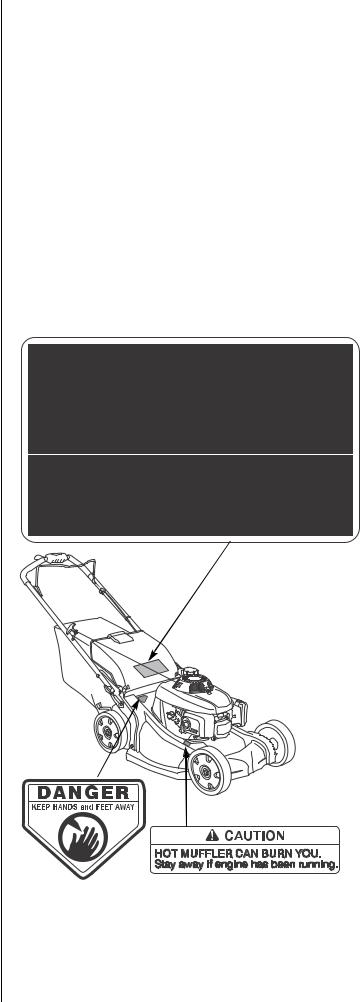
LAWN MOWER SAFETY
Most injuries or property damage with walk-behind mowers can be prevented if you follow all instructions in this manual and on the mower. The most common hazards are discussed below, along with the best way to protect yourself and others.
Avoid Rotating Blades
Rotating blades can cause serious cuts and even amputate fingers, hands, toes, or feet. Keep away from the mower deck whenever the engine is running. If you need to adjust the cutting height or work around the deck for any other reason, always shut off the engine. Wear heavy gloves and disconnect the spark plug cap when you need to clean the mower deck or handle the blades.
Clear Mowing Area
Mower blades can throw rocks and other objects with enough force to cause serious injury. Before mowing, carefully inspect the area and remove all sticks, stones, pieces of wire, and other loose objects. Never operate the blades over gravel.
Keep Shields in Place
Guards and shields are designed to protect you from being hit by thrown objects and from hot engine parts and moving components. For your safety and the safety of others, keep all shields in place when the engine is running.
Refuel with Care
Gasoline is extremely flammable and gasoline vapor can explode. Refuel only outdoors in a well-ventilated area with the engine OFF. Never smoke near gasoline and keep other flames and sparks away. Always store gasoline in an approved container.
Wear Protective Clothing
Wearing protective clothing will reduce your risk of injury. Long pants and eye protection reduce the risk of injuries from thrown objects. Sturdy shoes with aggressive soles will help protect your feet and give you better traction on slopes or uneven ground.
Turn Engine Off When Not Mowing
If you need to leave the mower for any reason, even just to inspect the lawn ahead, release the blade control lever to stop the engine.
IMPORTANT MESSAGE TO PARENTS
THE SAFETY OF YOUR CHILDREN IS VERY IMPORTANT to Honda. That’s why we urge you to read this message before letting your child operate this lawn mower. Lawn mowers are tools, not toys. As with any equipment, bad judgments can result in serious injuries. You can help prevent injuries or property damage by making good decisions about if, when, and how your child operates this equipment.
The first question you’ll need to ask is whether your child is capable of operating this mower safely. Remember, young people vary widely, and AGE IS NOT THE ONLY FACTOR.
Physically, a child must be LARGE ENOUGH AND STRONG ENOUGH to easily start the mower and control its direction. The child also needs enough size, strength, and coordination to comfortably reach and operate the controls.
A tougher question you need to ask is if your child has enough MATURITY AND RESPONSIBILITY to safely operate this mower. Does the young person think through problems and come to logical solutions? Be honest! Anyone who takes unnecessary risks and doesn’t obey rules should not operate this lawn mower.
2
If you decide that your son or daughter can handle the mower safely, CAREFULLY READ THE OWNER’S MANUAL with your child. Make sure you both understand all instructions and safety information. Also, be sure your child wears sturdy shoes and other protective clothing when operating or handling the mower.
SUPERVISION is also very important. Walk with your child during the first few minutes of mowing. Even after he or she has become confident with the mower, do not let him or her use the mower without good adult supervision. An adult should also be present during refueling and maintenance. In fact, it’s up to the adult owner to make sure that the mower is properly maintained and kept in safe operating condition.
By always placing safety first, your child will acquire useful skills and a sense of accomplishment. And you’ll both get the best results from your lawn mower.
SAFETY LABEL LOCATIONS
These labels warn you of potential hazards that can cause serious injury. Read them carefully. If a label comes off or becomes hard to read, contact an authorized Honda servicing dealer for a replacement.

SETTING UP YOUR MOWER
Unpacking
Remove all the cardboard from around the handlebar.
Handlebar Setup
BLADE CONTROL LEVER
|
UNLOCKED |
HANDLEBAR ADJUST
LOCKED
1.With the handlebar adjust knobs in the unlocked position, depress the blade control lever and raise the handlebar into the mowing position.
2.Align the adjust knobs with one of the three holes on the handle stay. Setting the adjust knobs in the lowest holes raises the handlebar to its highest position, and setting the adjust knobs in the highest holes lowers the handlebar to its lowest position.
3.Turn the adjusting knobs 90 degrees into the lock position, and the pins will spring into the holes and lock into position.
Grass Bag Assembly
1.Assemble the grass bag frame by pulling the support legs outward and sliding them into the eyelets as shown.
2.Install the assembled frame into the fabric grass bag, keeping the bag frame handle exposed.
BAG FRAME HANDLE |
FABRIC GRASS BAG |
|
|
|
|
|
|
|
SUPPORT LEGS
EYELETS
GRASS BAG
FRAME
PLASTIC CLIP
3. Install the plastic clips over the bag frame as shown.
4. Lift the discharge guard and install the grass bag.
Engine Oil
The mower is shipped
WITHOUT OIL in the engine.
A bottle of oil is included in the box with your mower. Add the entire contents of the oil bottle into the oil filler opening.
All Honda engines are run at the factory prior to packaging. Most of the oil is removed prior to shipment; however, some oil remains in the engine. The amount of oil left in the engine varies.
FILLER CAP/DIPSTICK
(Do not screw in the dipstick when checking the oil level)
If not using the supplied oil, |
|
|
add enough SAE 10W-30 |
UPPER LIMIT |
|
API service category SJ or |
LOWER LIMIT |
|
later oil to bring the oil level |
||
|
||
between the upper and |
|
|
lower limit marks on the dipstick as shown. |
|
Do not overfill the engine with oil. If the engine is overfilled, the excess oil may get transferred to the air cleaner housing and air filter.
After filling the engine with oil, remove the hang tag near the recoil starter grip that says “The engine has no oil. A container of oil is in the shipping box.”
Fuel
Refer to page 13.
Before Using Your Lawn Mower
Before using the lawn mower, all mower operators must read the following sections:
•LAWN MOWER SAFETY (page 2)
•CONTROL LOCATIONS (page 4)
•BEFORE OPERATION (page 4)
•OPERATION (page 7)
•MAINTENANCE SCHEDULE (page 9)
You can also find additional information on the Honda power equipment web site. Visit www.hondapowerequipment.com/faq/.
Please Register Your Lawn Mower
If your dealer did not collect registration information from you, please take a few minutes and register your purchase with Honda. This allows us to contact you with any important updates regarding your mower. Your information will remain confidential. It will not be released to any other company or organization. Please note, registration is not required to obtain warranty service.
You can register by completing and mailing the included registration card, or go online to www.hondapowerequipment.com and click on Product Registration.
3
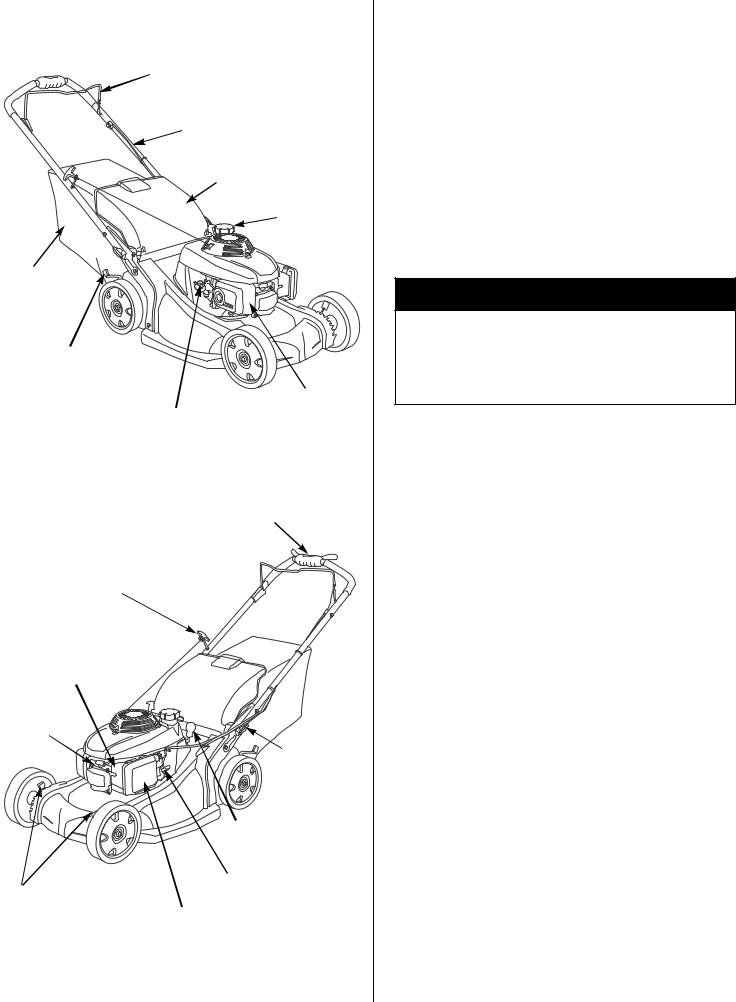
CONTROL LOCATIONS
BLADE CONTROL
LEVER (p. 7)
HANDLEBAR
(p. 3)
DISCHARGE GUARD
FUEL TANK
CAP (p. 13)
GRASS
BAG (p. 6)
REAR CUTTING HEIGHT ADJUSTMENT
LEVER (2) (p. 6)
MUFFLER
OIL FILLER CAP (p. 3)
SMART DRIVE CONTROL (p. 5)
RECOIL STARTER
GRIP (p. 7)
CARBURETOR
SPARK PLUG
CAP (p. 12)
HANDLEBAR ADJUST KNOB (2)
(p. 3)
CLIP DIRECTOR®
KNOB (p. 5)
FUEL VALVE (p. 7)
FRONT CUTTING |
|
|
HEIGHT ADJUSTMENT |
AIR CLEANER |
|
LEVERS (p. 6) |
||
(p. 11) |
||
|
4
BEFORE OPERATION
Your safety is your responsibility. A little time spent in preparation will significantly reduce your risk of injury.
Read and understand this manual. Know what the controls do and how to operate them.
Familiarize yourself with the lawn mower and its operation before you begin using it. Know how to shut off the lawn mower quickly in case of an emergency.
IS YOUR LAWN MOWER READY TO GO?
For your safety, and to maximize the service life of your lawn mower, it is very important to take a few moments before you operate the lawn mower to check its condition. Be sure to take care of any problem you find or have your servicing dealer correct it before you operate the lawn mower.
WARNING
Improperly maintaining this lawn mower or failing to correct a problem before operation could cause a malfunction in which you could be seriously injured.
Always perform a pre-operation inspection before each operation and correct any problem.
Before beginning your pre-operation checks, be sure the lawn mower is on a level surface.
Check the General Condition of the Lawn Mower
•Look around and underneath the lawn mower for signs of oil or gasoline leaks.
•Look for signs of damage.
•Check each control for proper operation.
•Check the blades for wear. Replace as necessary (page 9).
•Check that the blade bolts are tight (page 10).
•Check that all nuts, bolts, and screws are tightened.
Check the Engine
•Check the air cleaner (page 11) and oil level (page 11).
•Check the fuel level (page 13). Starting with a full tank will help eliminate or reduce operating interruptions for refueling.
CHECK YOUR MOWING AREA
For your safety and the safety of others, always inspect the area before operating the lawn mower.
Objects
Anything that can be picked up by the blades and thrown is a potential hazard to you and others. Look for things like stones, sticks, nails, and wire, and remove them from the mowing area.
People and Pets
People and animals near the work area can move into your lawn mower’s path or into a position where they could be struck by thrown objects. Clear the area of pets and people, especially children. Their safety is your responsibility.
Work Area
Check the condition of the grass. Adjust your lawn mower ground speed and mowing swath accordingly.
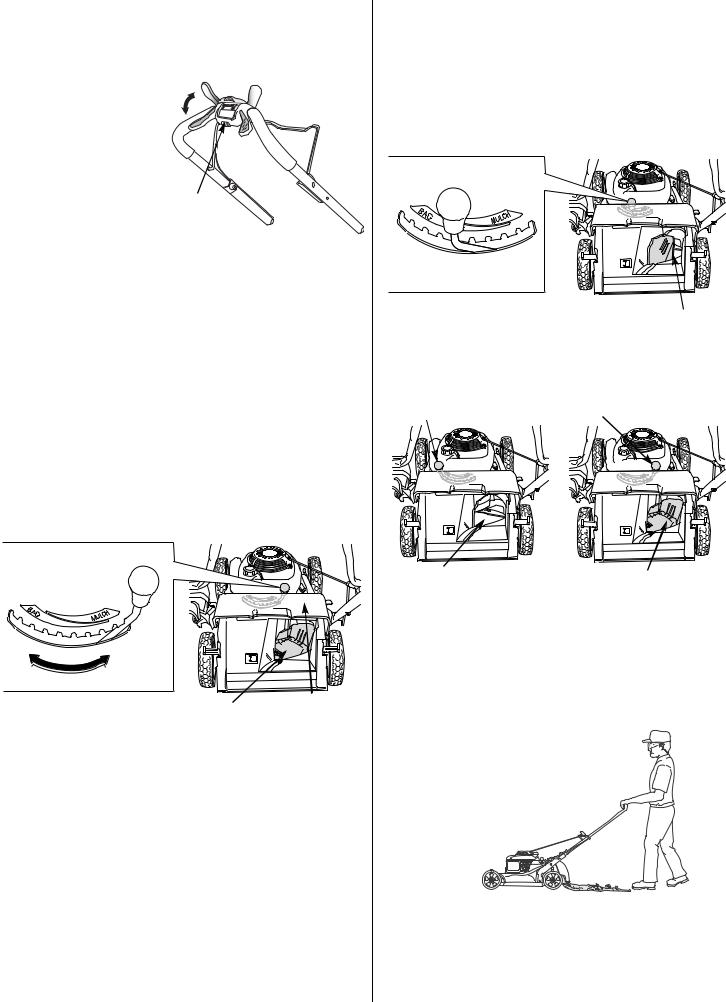
GET THE MOWER READY
Handlebar Height Adjustment
Adjust handlebar height for a comfortable operating position (page 3).
Smart Drive™ Control
The Smart Drive control can be adjusted up or down into any one of five positions.
Do not attempt to adjust the position of the Smart Drive control while the mower is in motion.
SMART DRIVE 
 CONTROL
CONTROL
 ™
™
CONTROL
Slide the multi-position adjuster
to the left to unlock the control, move the Smart Drive control
up or down into the most comfortable position, and then release the multi-position adjuster and allow it to engage.
Clip Director®
Adjust the Clip Director knob in any one of the ten positions to achieve the desired mowing results.
To adjust the Clip Director knob, pull the knob downward and towards the rear of the mower. The knob adjusts a sliding door from the fully open BAG position to the fully closed MULCH position.
Some grass accumulation in the discharge opening is normal when the Clip Director is fully closed. To remove this grass, close the discharge guard, fully open the Clip Director, engage the blade control lever, and start the engine.
If a high resistance is noticed when moving the Clip Director knob from side-to-side, excessive grass may have built up on top of the sliding door.
CLIP DIRECTOR KNOB
SLIDING DOOR |
DISCHARGE |
(fully closed) |
GUARD |
IMPORTANT SAFETY PRECAUTION
Always release the blade control lever and disconnect the spark plug cap (page 12) before lifting the discharge guard to view or clean around the sliding door. This will prevent contact with the rotating blades and prevent objects from being thrown into the discharge area.
Sliding Door Position
The sliding door can be positioned to produce different mowing results. If the preferred sliding door position is unknown, install the grass bag and begin mowing with the Clip Director knob all the way to the BAG position. Check the appearance of the lawn. As the knob is moved towards the MULCH position, more grass will be recycled back into the lawn. Adjust the Clip Director knob until the desired result is achieved.
|
BAGGING OR REAR DISCHARGE |
|||||||||||
CLIP DIRECTOR KNOB |
AND SOME MULCHING |
|||||||||||
|
|
|
|
|
|
|
|
|
|
|
|
|
|
|
|
|
|
|
|
|
|
|
|
|
|
|
|
|
|
|
|
|
|
|
|
|
|
|
|
|
|
|
|
|
|
|
|
|
|
|
|
|
|
|
|
|
|
|
|
|
|
|
|
|
|
|
|
|
|
|
|
|
|
|
|
|
|
|
|
|
|
|
|
|
|
|
|
|
|
|
|
|
|
|
|
|
|
|
|
|
|
|
|
|
|
|
|
|
|
|
|
|
|
|
|
|
|
|
|
|
|
|
|
|
|
|
|
|
|
|
SLIDING DOOR |
||
|
|
|
|
|
|
|
|
|
|
|
|
|
|
(50% open) |
||
FULL BAGGING OR |
FULL MULCHING |
|||||||||||||||
REAR DISCHARGE |
|
|||||||||||||||
|
|
|
|
|
|
|
|
|
|
|||||||
KNOB (BAG POSITION) |
|
|
KNOB (MULCH POSITION) |
|||||||||||||
|
|
|
|
|
|
|
|
|
|
|
|
|
|
|
|
|
|
|
|
|
|
|
|
|
|
|
|
|
|
|
|
|
|
|
|
|
|
|
|
|
|
|
|
|
|
|
|
|
|
|
|
|
|
|
|
|
|
|
|
|
|
|
|
|
|
|
|
|
|
|
|
|
|
|
|
|
|
|
|
|
|
|
|
|
SLIDING DOOR |
SLIDING DOOR |
(fully open) |
(fully closed) |
Rear Discharge
To discharge clippings to the rear, remove the grass bag and position the Clip Director knob in the BAG range. Maximum rear discharge will occur when the Clip Director knob is all the way to the left (BAG) position. As the Clip Director knob is moved toward the right (MULCH) position, less grass will be discharged through the rear discharge guard.
Fallen Leaves
Use the Clip Director to shred and collect fallen leaves for disposal. Set the front wheels so they are one or two settings higher than the rear. Set the Clip Director in position #9 (not quite full mulching), and adjust the setting from this point for best results.
5
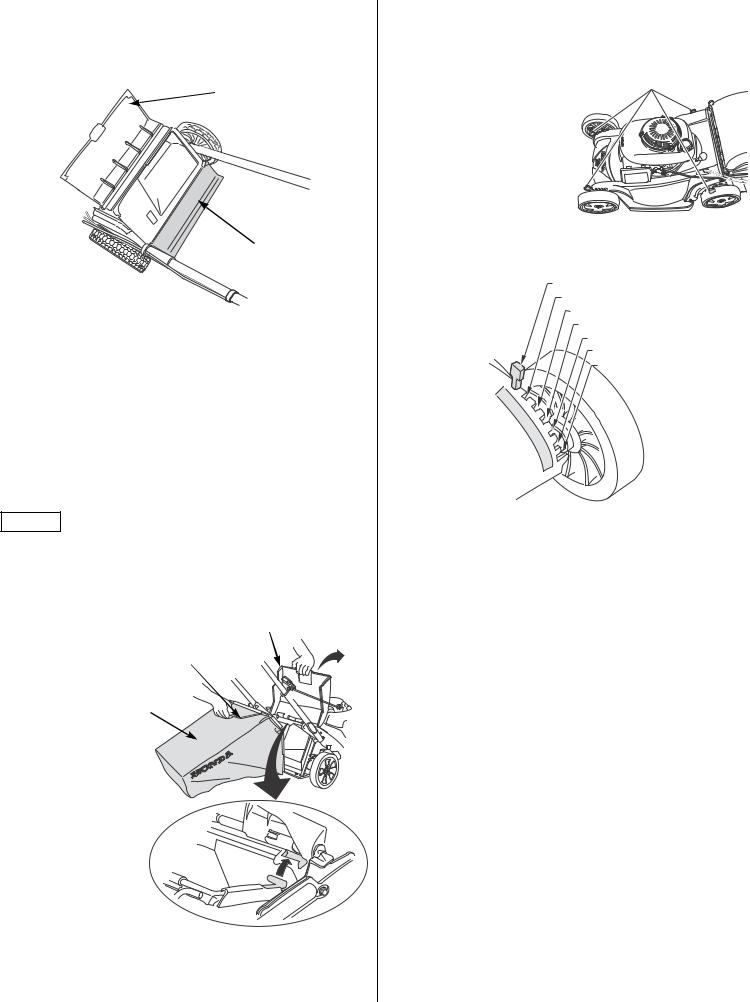
Rear Shield
During normal use the rear shield is subject to deterioration and wear. Remove the grass bag and raise the discharge guard to check the rear shield for cracks or tears. If the rear shield is excessively worn, have it replaced by your authorized Honda servicing dealer.
DISCHARGE GUARD
REAR SHIELD
Grass Bag
A lawn mower works like a vacuum cleaner; it blows air through the bag, which traps the grass clippings. Always empty the grass bag before it becomes filled to the limit of its capacity. Bagging performance will diminish after the bag becomes about 90% filled. Also, the bag is easier to empty when it is not packed full.
You can leave the grass bag on the mower during mowing, even when full mulching is selected, to meet various mowing conditions.
Inspection
During normal use, the grass bag material is subject to deterioration and wear.
NOTICE
Frequently inspect the grass bag for tears, holes, and excessive wear. Check for necessary replacement. Make sure the new bag meets the original specifications.
Grass bag replacement is explained on page 10.
Installation
1.Raise the discharge guard and hook the grass bag onto the mower deck as shown.
2.Release the discharge guard to secure the grass bag.
Removal
1.Raise the discharge guard, grasp the grass bag handle, and remove the grass bag.
2.Release the discharge guard.
DISCHARGE GUARD
GRASS BAG
HANDLE
BAG
3. When the grass bag is clear of the
discharge guard, you can lift it through the
handlebar opening, or you can remove it to the rear of the mower below the handlebar.
6
Cutting Height Adjustment
Each wheel of the mower can be adjusted to one of seven settings. The cutting height figures are approximate. The actual height of cut grass will vary with lawn and soil conditions.
Move all four adjustment levers to ADJUSTMENT LEVERS the same position.
To adjust cutting height, pull each adjustment lever toward the wheel, and move it into another notch.
If you are not sure what cutting height to select, start with a high setting and check the appearance of the lawn after mowing a small area. Then readjust the cutting height if necessary.
3/4 in (20 mm) 1-1/4 in (32 mm)
2 in (46 mm)
2-1/2 in (62 mm)
3 in (75 mm)
3-1/2 in (88 mm)
4 in (100 mm)
1
•
2
•
3
•
4
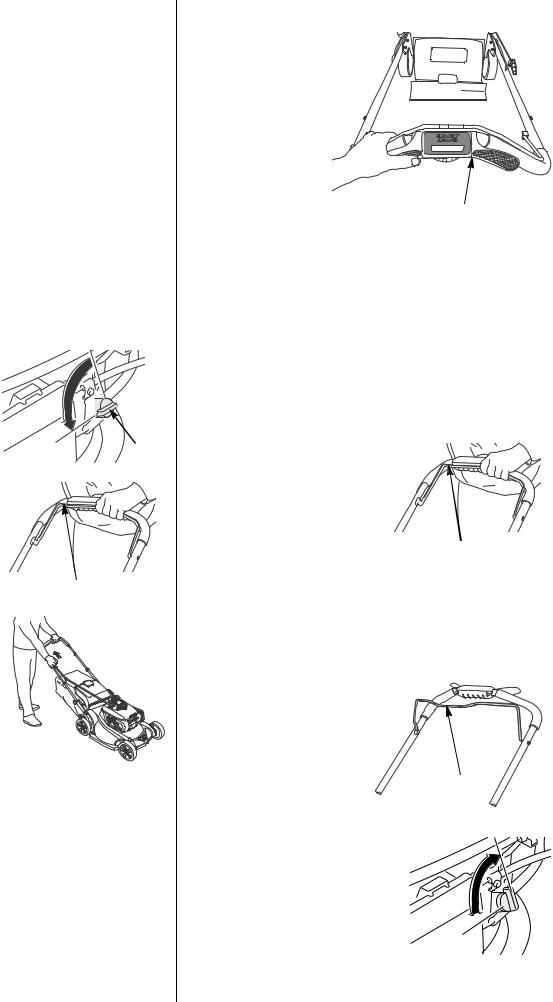
OPERATION
SAFE OPERATING PRECAUTIONS
Before operating the mower for the first time, please review LAWN MOWER SAFETY (page 2). Even if you have operated other mowers, take time to become familiar with how this mower works and practice in a safe area until you build up your skills. For your safety, avoid starting or operating the engine in an enclosed area, such as a garage. Your mower’s exhaust contains poisonous carbon monoxide gas, which can collect rapidly in an enclosed area and cause illness or death.
Frequency Of Use
If your equipment will be used on an infrequent or intermittent basis, (more than 4 weeks before next use), please refer to the Fuel section of the STORAGE chapter (page 14) for additional information regarding fuel deterioration.
STARTING THE ENGINE
Before starting, always release the Smart Drive control so that the mower will not move forward when you operate the starter.
1. Turn the fuel valve to the ON position.
|
ON |
FUEL |
|
|
|
||
|
|
VALVE |
|
2. Pull back on the blade control |
|
|
|
lever and hold it against the |
|
|
|
handlebar. |
|
|
|
The lever must be against the |
|
|
|
handlebar to start the engine. |
|
|
|
The blades start to rotate when |
BLADE CONTROL LEVER |
||
the lever is against the handlebar |
|||
|
|
||
and the recoil starter grip is |
|
|
|
pulled. |
|
|
|
3. Pull the starter grip lightly until you feel resistance, then pull
briskly. Return the starter grip gently.
Continue to hold the blade control lever against the handlebar; the engine stops when the blade control lever is released.
To ensure easy restarting and maximum performance from the Auto Choke System™, allow the engine to run for at least three minutes after starting a cold engine before shutting down. This minimum run time will be longer if the temperature is below 70°F (21°C).
OPERATING THE CONTROLS FOR MOWING
Smart Drive Control
Control position adjustment is described on page 5.
With the engine running |
|
and the blades rotating, |
|
slowly push the Smart |
|
Drive control to propel the |
™ |
CONTROL |
|
|
|
mower forward. |
|
Ground speed will increase as more pressure is applied to the Smart Drive control. After maximum ground speed is
obtained, applying additional pressure will not further increase ground speed. Apply only enough pressure to achieve the desired speed.
Ground speed control sensitivity will vary with such factors as terrain, grass height, slope, and grass bag weight. For example, achieving a very slow ground speed on smooth level terrain requires very light pressure applied to the Smart Drive control. However, additional pressure may be required to achieve the same ground speed on slopes, in tall grass, or on uneven terrain. The Smart Drive control is designed to allow you to move the control to maintain the desired ground speed under constantly changing mowing conditions.
Release the Smart Drive control to disengage (stop) the rear wheels.
Blade Control Lever
The lever must be pulled back against the handlebar to start the engine. The blade starts to rotate when the lever is pulled back against the handlebar and the recoil starter grip is pulled.
Continue to hold the lever against the handlebar. This will keep the engine and blade rotating smoothly
and prevent premature wear to the flywheel brake system.
Release the lever to stop the engine and stop blade rotation whenever you need to leave the mower.
STOPPING THE ENGINE
1. Release the blade control lever to stop the engine.
|
BLADE CONTROL |
|
LEVER |
2. When the mower is not in |
OFF |
use, turn the fuel valve to the OFF |
|
position. |
|
3. If your equipment will not be used for
3 to 4 weeks, we recommend running the engine’s carburetor out of fuel. You can do this by leaving the fuel valve OFF, restarting the engine and running it out of fuel. See “Fuel” on page 14 for periods of inactivity that exceed 4 weeks.
7

SAFE MOWING PRACTICES
For your safety, keep all four wheels on the ground and be careful to avoid losing your footing and your control of the mower. Keep a firm grip on the handlebar and walk, never run, with the mower. Be very careful when mowing uneven or rough ground.
If stuck, do not kick or shove the mower with your foot. Use the handlebar to control the mower.
WARNING
The blades are sharp and spin at high speed.
Spinning blades can cut you severely and can amputate fingers and toes.
•Wear protective footwear.
•Keep your hands and feet away from the mower deck while the engine is running.
•Stop the engine before performing any adjustment, inspection, or maintenance.
Slopes
Mow across slopes, not up and down. Avoid steep slopes (more than 20 ), and
be careful when changing direction. Mowing on a slope when the grass is damp or wet could cause you to slip, fall, and lose control of the mower.
Obstacles
Use the side of the mower to cut close to large obstacles, such as fences or walls.
Release the Smart Drive control to disengage the drive when mowing around trees and other obstacles. Push the mower around obstacles for better directional control. Be careful when mowing over obstacles embedded in the lawn, such as sprinkler heads, paving, edging, raised tree roots, etc. Avoid anything that sticks up above the surface of the lawn.
If a blade hits something or the mower starts to vibrate, stop the engine immediately, disconnect the spark plug cap, and check for damage (page 9). Striking objects may damage the blades, bend the crankshaft, and/or break the mower deck or other components. Vibration usually indicates serious trouble.
WARNING
A worn, cracked, or damaged blade can break, and pieces of the damaged blade can become dangerous projectiles.
Thrown objects can cause serious injury.
Inspect the blades regularly, and do not operate the mower with a worn or damaged blade.
The DISTRIBUTOR’S LIMITED WARRANTY (page 19) does not cover parts damaged by collision.
Gravel and Loose Objects
Gravel, loose stones, and landscaping material can be picked up by the mower and thrown many feet with enough force to cause serious personal injury and/or property damage. The best way to prevent potential injury from thrown objects is to release the blade control lever to stop the engine, and then push the mower across areas with gravel, loose stones, or landscaping material.
8
SERVICING YOUR LAWN MOWER
Good maintenance is essential for safe, economical, trouble-free operation. It will also help reduce air pollution.
WARNING
Improper maintenance or failure to correct a problem before operation can cause a malfunction in which you can be seriously hurt or killed.
Always follow the inspection and maintenance recommendations and schedules in this owner’s manual.
To help you properly care for your mower, the following pages include a maintenance schedule, routine inspection procedures, and simple maintenance procedures using basic hand tools. Other service tasks that are more difficult or require special tools are best handled by professionals and are normally performed by a Honda technician or other qualified mechanic.
The maintenance schedule applies to normal operating conditions. If you operate your mower under severe conditions, such as sustained high-load or high-temperature operation, or use in unusually wet or dusty conditions, consult your servicing dealer for recommendations applicable to your individual needs and use.
Remember that an authorized Honda servicing dealer knows your mower best and is fully equipped to maintain and repair it.
To ensure the best quality and reliability, use only new, Honda Genuine parts or their equivalents for repair and replacement.
Maintenance, replacement, or repair of the emission control devices and systems may be performed by any engine repair establishment or individual, using parts that are “certified” to EPA standards.
MAINTENANCE SAFETY
Some of the most important safety precautions follow. However, we cannot warn you of every conceivable hazard that can arise in performing maintenance. Only you can decide whether or not you
should perform a given task.
WARNING
Failure to properly follow maintenance instructions and precautions can cause you to be seriously hurt or killed.
Always follow the procedures and precautions in this owner’s manual.
Safety Precautions
•Make sure the engine is off before you begin any maintenance or repairs. This will eliminate several potential hazards:
–Carbon monoxide poisoning from engine exhaust
Be sure there is adequate ventilation whenever you operate the engine.
–Burns from hot parts
Let the engine and exhaust system cool before touching.
–Injury from moving parts
Do not run the engine unless instructed to do so.
